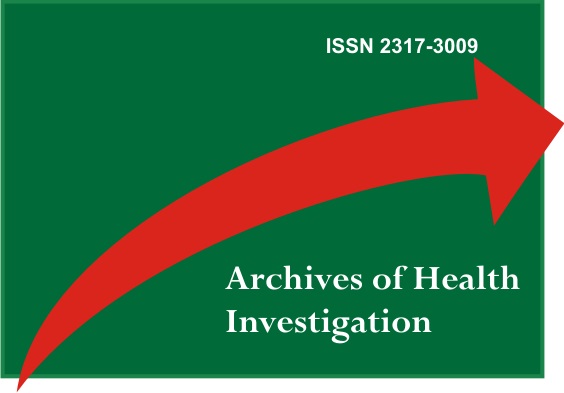Lesiones quísticas sincrónicas en los maxilares: reporte de casos
DOI:
https://doi.org/10.21270/archi.v10i8.5306Palavras-chave:
Queratoquiste Odontogénico, Ameloblastoma, Quiste del Conducto NasopalatinoResumo
La asociación de lesiones odontogenéticas afectando los huesos maxilares en un mismo paciente, es raro. El objetivo de este trabajo fue relatar dos casos de lesiones sincrónicas, afectando a un mismo paciente. En el primer caso, el paciente presentó un queratoquiste odontogénico en la mandíbula y un quiste del conducto nasopalatino, y en el segundo caso, el paciente presentó un ameloblastoma en la mandíbula y un quiste del conducto nasopalatino. Ambos casos fueron tratados a través de la remoción total de las lesiones, microscopicamente revelaron los respectivos diagnósticos y ahora estan siendo controlados, con la ausencia de recidivas después de cuatro años.
Downloads
Referências
Shear M. Cistos da Região Bucomaxilofacial - Diagnóstico e Tratamento. 3.ed. São Paulo: Santos, 1999.
Shylaja S, Balaji K, Krishna A. Nasopalatine duct cyst: report of a case with review of literature. Indian J Otolaryngol Head Neck Surg. 2013;65(4):385-8.
Martins MD, Russo MP, Bussadori SK, Fernandes KPS, Missawa GTM, Martins MAT. Nasopalatine duct cyst: report of case and literature review. Rev Inst Ciênc Saúde. 2007;25(2):193-7.
Suter VG, Sendi P, Reichart PA, Bornstein MM. The nasopalatine duct cyst: an analysis of the relation between clinical symptoms, cyst dimensions, and involvement of neighboring anatomical structures using cone beam computed tomography. J Oral Maxillofac Surg. 2011;69(10):2595-603
Philipsen HP. OM keratocystedr (Kolesteratomer) e kaeberne. Tandlaegebladet. 1956;60:963-71.
Pindborg J, Hansen J. Studies on odontogenic cyst epithelium. II. Clinical and roentgenographic aspects of odontogenic keratocysts. Acta Pathol Microbiol Scand. 1963;58:283.
Barnes L, Eveson JW, Reichart P, Sidransky D. World Health Organization Classification of Head and Neck Tumours. Pathology and Genetics of Head and Neck Tumours. 3rd ed. Lyon: IARC Press; 2005. p 160-1, 206-7.
Wright JM, Vered M. Update from the 4th Edition of the World Health Organization Classification of Head and Neck Tumours: Odontogenic and Maxillofacial Bone Tumors. Head Neck Pathol. 2017;11(1):68-77.
Menon S. Keratocystic Odontogenic Tumours: Etiology, Pathogenesis and Treatment Revisited. J Maxillofac Oral Surg. 2015;14(3):541-7.
Stoelinga PJW. The treatment of odontogenic keratocysts by excision of the overlying, attached mucosa, enucleation, and treatment of the bony defect with Carnoy solution. J Oral Maxillofac Surg. 2005;63:1662-6.
Carlson ER, Oreadi D, McCoy JM. Nevoid Basal Cell Carcinoma Syndrome and the Keratocystic Odontogenic Tumor. J Oral Maxillofac Surg. 2015;73(12Suppl):S77-86.
Maurette PE, Jorge J, de Moraes M. Conservative treatment protocol of odontogenic keratocyst: a preliminary study. J Oral Maxillofac Surg. 2006;64(3):379-83.
Chrcanovic BR, Gomez RS. Recurrence probability for keratocystic odontogenic tumors: An analysis of 6427 cases. J Craniomaxillofac Surg. 2017;45(2):244-51.
Kim J, Nam E, Yoon S. Conservative management (marsupialization) of unicystic ameloblastoma: literature review and a case report Maxillofac Plast Reconstr Surg. 2017;39(1):38
Mesquita JA, Luna AHB, Nonaka CFW, Godoy GP, Alves PM. Aspectos clínico, tomográfico e histopatológicos do cisto do ducto nasopalatino. Braz j otorhinolaryngol. 2014;80(5):448-50.
Kinard BE, Chuang SK, August M, Dodson TB. For treatment of odontogenic keratocysts, is enucleation, when compared to decompression, a less complex management protocol? J Oral Maxillofac Surg. 2015;73(4):641-8.
Lau SL, Samman N. Recurrence related to treatment modalities of unicystic ameloblastoma: a systematic review. Int J Oral Maxillofac Surg. 2006;35:681-90.
Zhang J, Gu Z, Jiang L, Zhao J, Tian M, Zhou J et al. Ameloblastoma in children and adolescents. Br J Oral Maxillofac Surg. 2010;48(7):549-54.
de Paulo LFB, Oliveira MTF, Rodrigues ÁR, Zanetta-Barbosa D. Treatment of an extensive unicystic ameloblastoma in a 7-year-old child: the best approach? Br J Oral Maxillofac Surg. 2015;53(3):292-4.


